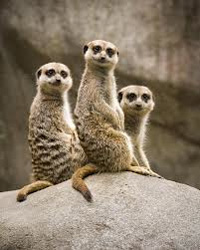 People have been fascinated with animals from time immemorial. From household pets to the extinct dinosaurs to unique and/or strange animals in the wild from other continents, each creature has its own special stage that invites study and inquiry from children to adults. Over the next two weeks, this book review column from The Children’s Literature and Reading SIG will be devoted to animals. Starting this week the books will deal with animals in the wild from animal habitats to wildlife protection and conservation. Next week will offer pets and other animals found in homes, farms, classrooms, or other habitats shared with humans.
People have been fascinated with animals from time immemorial. From household pets to the extinct dinosaurs to unique and/or strange animals in the wild from other continents, each creature has its own special stage that invites study and inquiry from children to adults. Over the next two weeks, this book review column from The Children’s Literature and Reading SIG will be devoted to animals. Starting this week the books will deal with animals in the wild from animal habitats to wildlife protection and conservation. Next week will offer pets and other animals found in homes, farms, classrooms, or other habitats shared with humans.
ReadWriteThink offers a number of lesson ideas that deal with animals, for example “Investigating Animals: Using Nonfiction for Inquiry-Based Research” or “Webcams in the Classroom: Animal Inquiry and Observation” and many, many more!
For more award-winning animal books, check out the Animal Behavior Society Book Children’s Book Award.
GRADES K-2
Bingham, Kelly. (2012). Z is for moose. Illus. by Paul O. Zelinksky. New York: HarperCollins/Greenwillow Books.
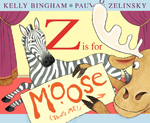 All the animals are set to take their places in Zebra’s ABC book. Eager to show off their best sides, the animals are carefully following Zebra's directions—well, everyone, that is, except the over-eager Moose. Prematurely bursting on the scene during the letter d, he causes all sorts of mayhem as he accidentally jabs Elephant in the side. After lurking around the other letters as he impatiently waits for his turn to come, Moose’s anticipation builds as time for the letter M draws near. But to his dismay and disappointment, there is no M is for moose in the line-up; instead, Zebra has decided to use another animal to represent the letter, making it M is for mouse and not moose. Moose understandably throws a fit and squashes the pie represented by P all over the next few letters. Eventually, Zebra relents and finds him a place in the alphabet line-up. Young readers will enjoy this cleverly written and illustrated title, and older readers certainly won’t mind reading it repeatedly while smiling at the colorful mixed media illustrations.
All the animals are set to take their places in Zebra’s ABC book. Eager to show off their best sides, the animals are carefully following Zebra's directions—well, everyone, that is, except the over-eager Moose. Prematurely bursting on the scene during the letter d, he causes all sorts of mayhem as he accidentally jabs Elephant in the side. After lurking around the other letters as he impatiently waits for his turn to come, Moose’s anticipation builds as time for the letter M draws near. But to his dismay and disappointment, there is no M is for moose in the line-up; instead, Zebra has decided to use another animal to represent the letter, making it M is for mouse and not moose. Moose understandably throws a fit and squashes the pie represented by P all over the next few letters. Eventually, Zebra relents and finds him a place in the alphabet line-up. Young readers will enjoy this cleverly written and illustrated title, and older readers certainly won’t mind reading it repeatedly while smiling at the colorful mixed media illustrations.
- Barbara A. Ward, Washington State University Pullman
Cohn, Scotti. (2013). On the move: mass migrations. Mount Pleasant, DC: Sylvan Dell Publishers.
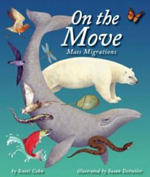 The concept of animal groups that include hundreds and/or thousands of a species that move together seasonally is explained in the opening pages as migration. With the recurring phrase of “on the move” the author describes the gathering of various species and continues the explanation with how they are moving and why. Often the reason is the mating season or getting ready for colder or warmer weather. Written in a narrative style this book is appropriate to introduce the concept of migration for early learners. Additional details and fact boxes are included at the end of the book. Educators will find a detailed and helpful resource and lesson guide at the publisher’s website.
The concept of animal groups that include hundreds and/or thousands of a species that move together seasonally is explained in the opening pages as migration. With the recurring phrase of “on the move” the author describes the gathering of various species and continues the explanation with how they are moving and why. Often the reason is the mating season or getting ready for colder or warmer weather. Written in a narrative style this book is appropriate to introduce the concept of migration for early learners. Additional details and fact boxes are included at the end of the book. Educators will find a detailed and helpful resource and lesson guide at the publisher’s website.
- Karen Hildebrand, Ohio Library and Reading Consultant
Curtis, Jennifer Keats. (2013). Animal helpers: Sanctuaries. Mount Pleasant, SC: Sylvan Dell.
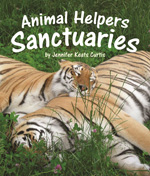 Many animals were never meant to be domesticated, but once they have been, they often cannot be released into the wild to fend for themselves. Six animal sanctuaries in the United States provide the material for this book’s stories about exotic animals that need a place to live out the rest of their lives after they have grown up. Often, their owners can no longer take care of them properly because of their size. Adorable baby animals often grow up to be more than a handful. The photographs and text offer ready testimony to the good work of these sanctuaries that provide a safe place for the animals left behind or surrendered to authorities for the animals’ own well-being. Readers will encounter brief stories about a Canadian lynx, bobcats, tigers, a bear, and a jaguar, among others. Additionally, the book shows the hard work that is required of the animals' caretakers try to keep them occupied and healthy. Truly, this must be a labor of love. Also see "5 Questions With... Wendy Henrichs (When Anju Loved Being an Elephant)" on the Engage blog.
Many animals were never meant to be domesticated, but once they have been, they often cannot be released into the wild to fend for themselves. Six animal sanctuaries in the United States provide the material for this book’s stories about exotic animals that need a place to live out the rest of their lives after they have grown up. Often, their owners can no longer take care of them properly because of their size. Adorable baby animals often grow up to be more than a handful. The photographs and text offer ready testimony to the good work of these sanctuaries that provide a safe place for the animals left behind or surrendered to authorities for the animals’ own well-being. Readers will encounter brief stories about a Canadian lynx, bobcats, tigers, a bear, and a jaguar, among others. Additionally, the book shows the hard work that is required of the animals' caretakers try to keep them occupied and healthy. Truly, this must be a labor of love. Also see "5 Questions With... Wendy Henrichs (When Anju Loved Being an Elephant)" on the Engage blog.
- Barbara A. Ward, Washington State University Pullman
Formento, Alison. (2012). These bees count. Illus. by Sarah Snow. Park Ridge, IL: Albert Whitman & Company.
 When Mr. Tate’s class visits a farm on a school field trip, the students learn all about busy bee work that goes into creating honey. The children even have the chance to don the gear beekeepers use, complete with nets to cover their faces. The farmer, a woman named Ellen, shows them the beehives, explains how bees collect pollen from flowers, and demonstrates how she uses smoke to send them out of the hive. Although the book title is a play on words since the bees count when it comes to making honey, it also allows readers to count the number of elements on the pages; for instance, there are five poppies reaching for the sun on one page and nine peapods whose vines cling to stakes. Back matter includes information on bees and even a brief discussion about colony collapse disorder. The vivid illustrations and honeycombed endpapers add immensely to the pleasures of reading this short text. Without bees, life would lose much of its sweetness.
When Mr. Tate’s class visits a farm on a school field trip, the students learn all about busy bee work that goes into creating honey. The children even have the chance to don the gear beekeepers use, complete with nets to cover their faces. The farmer, a woman named Ellen, shows them the beehives, explains how bees collect pollen from flowers, and demonstrates how she uses smoke to send them out of the hive. Although the book title is a play on words since the bees count when it comes to making honey, it also allows readers to count the number of elements on the pages; for instance, there are five poppies reaching for the sun on one page and nine peapods whose vines cling to stakes. Back matter includes information on bees and even a brief discussion about colony collapse disorder. The vivid illustrations and honeycombed endpapers add immensely to the pleasures of reading this short text. Without bees, life would lose much of its sweetness.
- Barbara A. Ward, Washington State University Pullman
Holland, Mary. (2013). Ferdinand Fox’s first summer. Mount Pleasant, SC: Sylvan Dell Publishers.
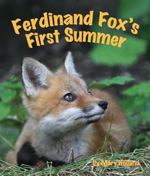 Nature photographer Mary Holland has captured the first few months in the life of a young fox through her camera. Mary named him Ferdinand, and young readers will follow this young kit and his four brothers and sisters from the underground den where they were born to the world of the forest and their lessons in how to survive. Double page photographs on every page give a close-up feel as readers observe how these young kits use their senses to learn about their environment. The kits’ playful antics are also captured in these beautiful nature photographs. Not a detailed introduction but one for early learners, the information about Ferdinand Fox is told as a nonfiction narrative easily understood by primary age students. Teachers will find a detailed lesson guide at the publisher’s website. Learn more about the author, her photography and the background for this book at her blog and website.
Nature photographer Mary Holland has captured the first few months in the life of a young fox through her camera. Mary named him Ferdinand, and young readers will follow this young kit and his four brothers and sisters from the underground den where they were born to the world of the forest and their lessons in how to survive. Double page photographs on every page give a close-up feel as readers observe how these young kits use their senses to learn about their environment. The kits’ playful antics are also captured in these beautiful nature photographs. Not a detailed introduction but one for early learners, the information about Ferdinand Fox is told as a nonfiction narrative easily understood by primary age students. Teachers will find a detailed lesson guide at the publisher’s website. Learn more about the author, her photography and the background for this book at her blog and website.
- Karen Hildebrand, Ohio Library and Reading Consultant
Kaner, Etta. (2013). And the winner is…Amazing animal athletes. Illus. by David Anderson. Tonawanda, NY: Kids Can Press.
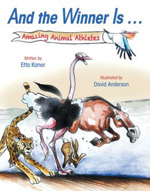 With illustrations and information about various types of habitats, this text features an imaginary World Animal Games in which animals compete against each other to prove their prowess in various events. Walrus and Cockatoo banter while introducing the competition. The events include the high jump, sprinting, weight lifting, swimming, the long jump, aerobatics, and the marathon. Several competitors are described, and then guesses are made about who might win. Each time the winner of the event is revealed, and then his/her time is compared to the most accomplished human athlete’s. Some of the winners are surprising while others are predictable. While the other animals watch the competitors, their observations about what they are seeing add to the fun. Thumbnail sketches provide additional information such as food and habitat about the animals in the completion. Human athletes simply can’t compare to these athletic animals. Readers will love the cartoonlike illustrations and shake their heads at these amazing feats by animals.
With illustrations and information about various types of habitats, this text features an imaginary World Animal Games in which animals compete against each other to prove their prowess in various events. Walrus and Cockatoo banter while introducing the competition. The events include the high jump, sprinting, weight lifting, swimming, the long jump, aerobatics, and the marathon. Several competitors are described, and then guesses are made about who might win. Each time the winner of the event is revealed, and then his/her time is compared to the most accomplished human athlete’s. Some of the winners are surprising while others are predictable. While the other animals watch the competitors, their observations about what they are seeing add to the fun. Thumbnail sketches provide additional information such as food and habitat about the animals in the completion. Human athletes simply can’t compare to these athletic animals. Readers will love the cartoonlike illustrations and shake their heads at these amazing feats by animals.
- Barbara A. Ward, Washington State University Pullman
Loxton, Daniel. (2013). Tales of prehistoric life: Pterosaur trouble. Illus. by Daniel Loxton with Jim W. W. Smith. Tonawanda, NY: Kids Can Press.
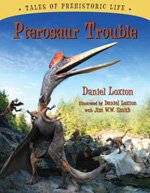 This book filled with luminous illustrations of Earth’s prehistoric period will captivate young readers fascinated by the age of the dinosaurs. Inspired by the discovery of a fossil of a large flying reptile with bite marks from a smaller creature, the author imagines the outcome of a battle between two fierce competitors. Unconcerned with the dinosaurs below him, Quetzalcoatlus, a pterosaur, flies through the air and surveys his domain before landing to hunt for food. As he fishes and considers whether a diminutive feathered dinosaur could be his next meal, he suddenly finds that the predator has become the prey of several of those Saurornitholestes who have surrounded him. The fact that the battle is hard fought and its result is not certain will keep readers turning the pages. This is an excellent way to engage readers while giving them a glimpse into a world that no longer exists. The back matter provides information about the pterosaur, a huge flying reptile. The blend of speculative fiction and nonfiction is quite appealing.
This book filled with luminous illustrations of Earth’s prehistoric period will captivate young readers fascinated by the age of the dinosaurs. Inspired by the discovery of a fossil of a large flying reptile with bite marks from a smaller creature, the author imagines the outcome of a battle between two fierce competitors. Unconcerned with the dinosaurs below him, Quetzalcoatlus, a pterosaur, flies through the air and surveys his domain before landing to hunt for food. As he fishes and considers whether a diminutive feathered dinosaur could be his next meal, he suddenly finds that the predator has become the prey of several of those Saurornitholestes who have surrounded him. The fact that the battle is hard fought and its result is not certain will keep readers turning the pages. This is an excellent way to engage readers while giving them a glimpse into a world that no longer exists. The back matter provides information about the pterosaur, a huge flying reptile. The blend of speculative fiction and nonfiction is quite appealing.
- Barbara A. Ward, Washington State University Pullman
Lynette, Rachel. (2013). Pink River Dolphins. New York: Bearport Press.
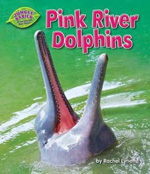 The unusual pink river dolphins have only been “found in the lakes and rivers of South America’s rain forests.” (p.8) With a photograph on one page and a map inset on the other, primary age readers will begin their journey to discover information about these unique dolphins. Using a small format for little hands but larger font size, this early reader science book introduces the life of the pink river dolphin. Boldface words indicate vocabulary emphasis to describe various aspects of the life and environment of these mammals and a glossary with photographs further explain the words at the back of the book. Topics include special skills like echolocation, giving birth, time to eat, playtime, and growing up. Use this short video from National Geographic to give students a real live look at these unusual creatures.
The unusual pink river dolphins have only been “found in the lakes and rivers of South America’s rain forests.” (p.8) With a photograph on one page and a map inset on the other, primary age readers will begin their journey to discover information about these unique dolphins. Using a small format for little hands but larger font size, this early reader science book introduces the life of the pink river dolphin. Boldface words indicate vocabulary emphasis to describe various aspects of the life and environment of these mammals and a glossary with photographs further explain the words at the back of the book. Topics include special skills like echolocation, giving birth, time to eat, playtime, and growing up. Use this short video from National Geographic to give students a real live look at these unusual creatures.
- Karen Hildebrand, Ohio Library and Reading Consultant
Markle, Sandra. (2013). What if you had animal teeth!? Illus. by Howard McWilliam. New York: Scholastic.
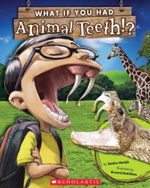 In this funny book sure to be a hit with young readers, the author imagines that the book’s reader has lost his/her front teeth. Instead of the permanent teeth that will replace those choppers, she wonders what might happen if various animals’ teeth grew in the mouth instead. The lively text, photographs, and quirky illustrations charmingly tell a great tooth story. By turns, the children in the illustrations have mouths filled with the teeth of a beaver, a great white shark, a narwhal, an elephant, a rattlesnake, a naked mole rat, a vampire bat, a hippopotamus, a Bengal tiger, a crocodile, and a camel. After taking readers on this informative flight of fancy, the author explains the origin of teeth and discusses proper tooth care. This short title is guaranteed to prompt readers to flash their pearly whites in delight.
In this funny book sure to be a hit with young readers, the author imagines that the book’s reader has lost his/her front teeth. Instead of the permanent teeth that will replace those choppers, she wonders what might happen if various animals’ teeth grew in the mouth instead. The lively text, photographs, and quirky illustrations charmingly tell a great tooth story. By turns, the children in the illustrations have mouths filled with the teeth of a beaver, a great white shark, a narwhal, an elephant, a rattlesnake, a naked mole rat, a vampire bat, a hippopotamus, a Bengal tiger, a crocodile, and a camel. After taking readers on this informative flight of fancy, the author explains the origin of teeth and discusses proper tooth care. This short title is guaranteed to prompt readers to flash their pearly whites in delight.
- Barbara A. Ward, Washington State University Pullman
Sebe, Masayuki. (2013). 100 animals on parade! Tonawanda, NY: Kids Can Press.
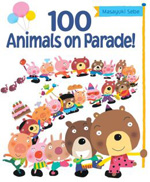 While this counting book features almost more animals than a reader can bear to count, it’s also an activity book and inquiry text designed to sharpen readers’ visual literacy skills as well as their critical thinking skills. For instance, there are clever quips and questions above some of the animals and readers are asked to find certain bears such as the last one or the one whose strength allows him to hoist a piano. The book begins with 100 musically inclined bears at the front of a parade. They are followed by 11 pig chefs hauling scrumptious foods, 100 carpenter beetles carrying heavy objects, 100 circus rabbits doing tricks, and 100 flower birds zipping through the sky. The final double-page spread shows where all those animals are heading, revealing a crowded, animal-filled place. Readers are encouraged to return to the earlier pages to find three animals that appear in every scene as well as to locate 22 additional items in the final scene.
While this counting book features almost more animals than a reader can bear to count, it’s also an activity book and inquiry text designed to sharpen readers’ visual literacy skills as well as their critical thinking skills. For instance, there are clever quips and questions above some of the animals and readers are asked to find certain bears such as the last one or the one whose strength allows him to hoist a piano. The book begins with 100 musically inclined bears at the front of a parade. They are followed by 11 pig chefs hauling scrumptious foods, 100 carpenter beetles carrying heavy objects, 100 circus rabbits doing tricks, and 100 flower birds zipping through the sky. The final double-page spread shows where all those animals are heading, revealing a crowded, animal-filled place. Readers are encouraged to return to the earlier pages to find three animals that appear in every scene as well as to locate 22 additional items in the final scene.
- Barbara A. Ward, Washington State University Pullman
Shields, Amy. (2013). National Geographic Kids: Saving animal babies. Washington, DC: National Geographic.
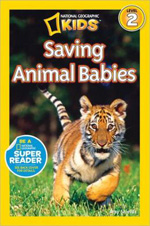 In simple but engaging text this book provides glimpses into how humans are working hard to take care of baby animals. From feeding milk shakes concocted from meat to tiger cubs whose mothers are unable to care properly for their first litter to rewiring a starving seal lion’s broken jaw before releasing him back to his ocean home, this book is filled with heart-warming stories and photographs showing men and women making a difference in the lives of wild animals. A section in the back of the book offers a list of simple do’s and don’ts that readers can follow to help save animal babies in their own way.
In simple but engaging text this book provides glimpses into how humans are working hard to take care of baby animals. From feeding milk shakes concocted from meat to tiger cubs whose mothers are unable to care properly for their first litter to rewiring a starving seal lion’s broken jaw before releasing him back to his ocean home, this book is filled with heart-warming stories and photographs showing men and women making a difference in the lives of wild animals. A section in the back of the book offers a list of simple do’s and don’ts that readers can follow to help save animal babies in their own way.
- Barbara A. Ward, Washington State University
Stockdale, Susan. (2013). Stripes of all types. Atlanta: Peachtree Publications.
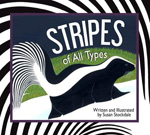 “Stripes found in water/ sliding through weeds/Drinking from rivers/ and darting through reeds.” (p.1-4) Rhyming narrative coupled with colorful illustrations, often as double-page spreads, introduce the concept of nature’s camouflage in animals around the world. This science concept book is appropriate for early readers not only to look at the stripes themselves but how patterns work in nature as well. Placed in their natural habitats, Stockdale has created captivating illustrations. Read more about how she created these beautiful illustrations at the publisher’s website/blog. The end of the book includes thumbnail illustrations with further background information and the final pages have a matching game for young readers, or teachers with an electronic whiteboard. Enjoy the other books by award-winning author, Susan Stockdale, through this Voice of America video.
“Stripes found in water/ sliding through weeds/Drinking from rivers/ and darting through reeds.” (p.1-4) Rhyming narrative coupled with colorful illustrations, often as double-page spreads, introduce the concept of nature’s camouflage in animals around the world. This science concept book is appropriate for early readers not only to look at the stripes themselves but how patterns work in nature as well. Placed in their natural habitats, Stockdale has created captivating illustrations. Read more about how she created these beautiful illustrations at the publisher’s website/blog. The end of the book includes thumbnail illustrations with further background information and the final pages have a matching game for young readers, or teachers with an electronic whiteboard. Enjoy the other books by award-winning author, Susan Stockdale, through this Voice of America video.
- Karen Hildebrand, Ohio Library and Reading Consultant
Thomas, Isabel. (2013). Brilliant Birds. Mankato, MN: Raintree Publishers.
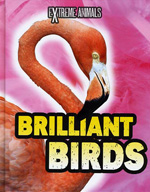 From the Extreme Animals series, this bright pink cover advertises the contents of this book about the colorful birds from around the world that are described on the inside pages. Colorful photography, “Did you know” fact boxes, new vocabulary in bold print, miscellaneous factoid boxes in addition to opening paragraphs describe each of the birds and species. Regal Eagles, Helicopter Hummingbirds, Outsized Ostriches, Tough Penguins, Fearless Flamingo, Soaring Albatrosses, Clever Crows, Tongue-Twisting Woodpeckers, Noisy Kakapos and Revolting Vultures are a few of the chapter headings about specific bird types.
From the Extreme Animals series, this bright pink cover advertises the contents of this book about the colorful birds from around the world that are described on the inside pages. Colorful photography, “Did you know” fact boxes, new vocabulary in bold print, miscellaneous factoid boxes in addition to opening paragraphs describe each of the birds and species. Regal Eagles, Helicopter Hummingbirds, Outsized Ostriches, Tough Penguins, Fearless Flamingo, Soaring Albatrosses, Clever Crows, Tongue-Twisting Woodpeckers, Noisy Kakapos and Revolting Vultures are a few of the chapter headings about specific bird types.
- Karen Hildebrand, Ohio Library and Reading Consultant
Townsend, John. (2013). Amazing Animal Helpers. Mankato, MN: Raintree.
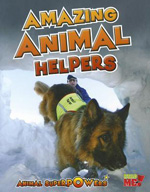 From the Animal Superpowers series, extraordinary capabilities of a wide variety of animals fill the pages of this book. Photographs of these animals in their habitats explain what their special talents are. Pigeons that were used to carry messages during World War II or Mila, the Beluga whale that saved a diver from drowning in Chine, or the gorilla living in a zoo near Chicago that saved a three-year-old boy when he fell into her pen and rushed to save him are just a few of the feats these animals accomplished. From tiny insect “mini superheroes” (p.12) to tsunami-warning elephants in Thailand, amazing facts and accomplishments of wonderful animal acts of kindness, compassion, strength, or friendship are described about these animal helpers. For more, read about Dorothy Hinshaw Patent (author of Dogs on Duty) on the Engage blog.
From the Animal Superpowers series, extraordinary capabilities of a wide variety of animals fill the pages of this book. Photographs of these animals in their habitats explain what their special talents are. Pigeons that were used to carry messages during World War II or Mila, the Beluga whale that saved a diver from drowning in Chine, or the gorilla living in a zoo near Chicago that saved a three-year-old boy when he fell into her pen and rushed to save him are just a few of the feats these animals accomplished. From tiny insect “mini superheroes” (p.12) to tsunami-warning elephants in Thailand, amazing facts and accomplishments of wonderful animal acts of kindness, compassion, strength, or friendship are described about these animal helpers. For more, read about Dorothy Hinshaw Patent (author of Dogs on Duty) on the Engage blog.
- Karen Hildebrand, Ohio Library and Reading Consultant
GRADES 3-5
Alderfer, Jonathan. (2013). National Geographic Kids Bird Guide of North America. Washington, DC: National Geographic.
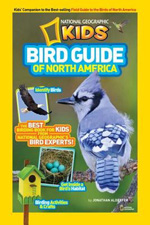 Divided into eleven sections based on geographic parts of the United States such as “Eastern Backyard Birds” and specific types of habitat such as “City Streets and Parks,” “Farms and Fields,” “Beach and Bay,” “River and Marsh,” and “Deserts,” among others, this is the definitive field guide for young birders. Its slim size makes it easy to tote, and its color-coded sections allow birders to quickly refer to a section and identify a bird. Each section features a double-page photo spread showing a bird in its typical habitat. The rest of the section provides vital statistics such as voice, food, habitat and range, about the birds commonly found in that area as well a closer look at the bird’s physical features. Readers are sure to enjoy the section entitled “Rock Star Birds” featuring birds that are considered rather flashy. Among them can be found the Whooping Crane, the Roseate Spoonbill, the California Condor, the Snowy Owl, the Trumpeter Swan, and the Atlantic Puffin, gorgeous winged wonders that every birder longs to spot.
Divided into eleven sections based on geographic parts of the United States such as “Eastern Backyard Birds” and specific types of habitat such as “City Streets and Parks,” “Farms and Fields,” “Beach and Bay,” “River and Marsh,” and “Deserts,” among others, this is the definitive field guide for young birders. Its slim size makes it easy to tote, and its color-coded sections allow birders to quickly refer to a section and identify a bird. Each section features a double-page photo spread showing a bird in its typical habitat. The rest of the section provides vital statistics such as voice, food, habitat and range, about the birds commonly found in that area as well a closer look at the bird’s physical features. Readers are sure to enjoy the section entitled “Rock Star Birds” featuring birds that are considered rather flashy. Among them can be found the Whooping Crane, the Roseate Spoonbill, the California Condor, the Snowy Owl, the Trumpeter Swan, and the Atlantic Puffin, gorgeous winged wonders that every birder longs to spot.
- Barbara A. Ward, Washington State University Pullman
Allen, Kathy. (2013). Polar Bears. Mankato, MN: Capstone Press.
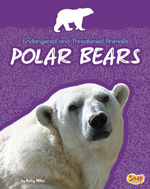 From the Endangered and Threatened Animals series, this introduction to the polar bear is well developed. Beginning with a description of the species and its habitat, complete with an aerial view of the Arctic Circle, the life of the polar bear is discussed including how they hunt to acquire food and how their bodies and fur are designed to maximize hunting techniques as well as surviving arctic temperatures. Vocabulary used to describe aspects of the life of the polar bear appear in bold face print in addition to vocabulary boxes placed throughout the books. Captioned color photographs add to the background information about this endangered species. The final chapter discusses the reasons the polar bear is being threatened and how people, including kids, can help in the efforts to preserve this beautiful white bear. Catch “The Animal Planet” TV show that features the endangered polar bear now.
From the Endangered and Threatened Animals series, this introduction to the polar bear is well developed. Beginning with a description of the species and its habitat, complete with an aerial view of the Arctic Circle, the life of the polar bear is discussed including how they hunt to acquire food and how their bodies and fur are designed to maximize hunting techniques as well as surviving arctic temperatures. Vocabulary used to describe aspects of the life of the polar bear appear in bold face print in addition to vocabulary boxes placed throughout the books. Captioned color photographs add to the background information about this endangered species. The final chapter discusses the reasons the polar bear is being threatened and how people, including kids, can help in the efforts to preserve this beautiful white bear. Catch “The Animal Planet” TV show that features the endangered polar bear now.
- Karen Hildebrand, Ohio Library and Reading Consultant
Arlon, Penelope and Tory Gordon-Harris. (2013). Scholastic Discover More: Rainforest. New York: Scholastic.
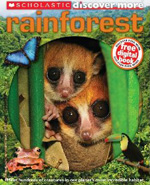 As the earth’s lungs, the rainforest takes care of all lives on the planet. The rainforest is a most incredible habitat in which more than half of the Earth’s species dwell. The hot-sun-and-heavy-rain weather cycle of the rainforest breeds giant plants that almost seem cunning as well as colorful animals capable of camouflaging themselves in their surroundings. The rainforest is also the place from which many of our favorite foods and products come. Enjoy a cup of hot chocolate with marshmallows at a cold winter night? Can’t wait to put on a pair of colorful and stylish rain boots in a drizzling day? Prefer a banana as a snack during the afternoon break? Without the rainforest, there would be no chocolate, no rain boots, and no bananas. Deforestation and global warming have raised our concern about the conservation of the rainforest. This introductory text explains what the rainforest is and why it matters, heightening the awareness of young readers about their environment. While reading this book, readers will relish many fun and amazing facts about the rainforest.
As the earth’s lungs, the rainforest takes care of all lives on the planet. The rainforest is a most incredible habitat in which more than half of the Earth’s species dwell. The hot-sun-and-heavy-rain weather cycle of the rainforest breeds giant plants that almost seem cunning as well as colorful animals capable of camouflaging themselves in their surroundings. The rainforest is also the place from which many of our favorite foods and products come. Enjoy a cup of hot chocolate with marshmallows at a cold winter night? Can’t wait to put on a pair of colorful and stylish rain boots in a drizzling day? Prefer a banana as a snack during the afternoon break? Without the rainforest, there would be no chocolate, no rain boots, and no bananas. Deforestation and global warming have raised our concern about the conservation of the rainforest. This introductory text explains what the rainforest is and why it matters, heightening the awareness of young readers about their environment. While reading this book, readers will relish many fun and amazing facts about the rainforest.
- Ying-Hsuan Lee, Washington State University Pullman
Berger, Melvin & Gilda. (2013). 101 animal records. New York: Scholastic.
 Nature lovers will certainly enjoy this fascinating look at animals. Starting with the number 1 and moving all the way to 101, the title provides interesting facts and records held by animals. For instance, one represents Lonesome George, the Abington tortoise who was the last of his kind. After his death in 2012, there were no others of his species left on the Earth. Number ten represents the basilisk lizard, whose webbed hind feet make it able almost to skim across the water. With more time spent asleep than awake, the koala holds down the sixtieth spot as the sleepiest mammal, slumbering away 18 hours of each day. The book concludes with the wolverine at the 101st spot, earning it because of its strength for its size. The enticing text and photographs guarantee that readers will be reluctant to look up from this book’s pages.
Nature lovers will certainly enjoy this fascinating look at animals. Starting with the number 1 and moving all the way to 101, the title provides interesting facts and records held by animals. For instance, one represents Lonesome George, the Abington tortoise who was the last of his kind. After his death in 2012, there were no others of his species left on the Earth. Number ten represents the basilisk lizard, whose webbed hind feet make it able almost to skim across the water. With more time spent asleep than awake, the koala holds down the sixtieth spot as the sleepiest mammal, slumbering away 18 hours of each day. The book concludes with the wolverine at the 101st spot, earning it because of its strength for its size. The enticing text and photographs guarantee that readers will be reluctant to look up from this book’s pages.
- Barbara A. Ward, Washington State University
Burnie, David. (2013). Scholastic Discover More: Sharks. New York: Scholastic.
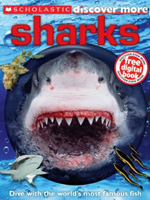 Not only do sharks have sharp teeth, streamlined bodies, but they are one of the most powerful predators swimming in the ocean. Swimming with stealth and speed when they attack, they swim even when they sleep. Humans both loathe and love them. They are feared for the well-publicized attacks on surfers when surfers paddle like turtles. But some humans love them for their fins, used in soups. Sharks are old, having been around more than 420 million years. They are good swimmers who travel from ocean to ocean. The photos in this engaging book are clear enough that readers may feel excited or scared as the pages are turned and sharks in all their glory are revealed. Readers will find descriptions and explanations of characteristics of sharks that are informative and easy to digest. The inclusion of myths and legends surrounding sharks adds to the reading pleasure. This is a good book for youngsters to read before visiting an aquarium or simply to know more about the importance of sharks. There’s much more to the story of sharks than what is shown in movies.
Not only do sharks have sharp teeth, streamlined bodies, but they are one of the most powerful predators swimming in the ocean. Swimming with stealth and speed when they attack, they swim even when they sleep. Humans both loathe and love them. They are feared for the well-publicized attacks on surfers when surfers paddle like turtles. But some humans love them for their fins, used in soups. Sharks are old, having been around more than 420 million years. They are good swimmers who travel from ocean to ocean. The photos in this engaging book are clear enough that readers may feel excited or scared as the pages are turned and sharks in all their glory are revealed. Readers will find descriptions and explanations of characteristics of sharks that are informative and easy to digest. The inclusion of myths and legends surrounding sharks adds to the reading pleasure. This is a good book for youngsters to read before visiting an aquarium or simply to know more about the importance of sharks. There’s much more to the story of sharks than what is shown in movies.
- Ying-Hsuan Lee, Washington State University Pullman
Cerullo, Mary M. with Clyde F. E. Roper.(2012). Giant squid: searching for a sea monster. Mankato, MN: Capstone Press.
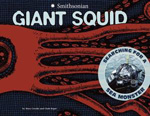 The scientific work of Dr. Clyde Roper is featured in this fascinating look at the mysterious deep-sea creature, the giant squid. Found to be 50 feet long with eyes the size of a man’s head, these cephalopods have eluded man for years and also have a strange trail of lore and mystery in sea stories and novels. Dr. Roper’s study of the giant squid reveals much about them and author Mary Cerullo has narrated his work for young readers. Illustrated with a mix of actual photographs, charts, diagrams and illustrations this narrative provides an enormous amount of factual information about this little-known subject in addition to pieces of some of the sea lore that surrounds them. Sightings of these rare animals are few partly because they live in the freezing depths of the ocean usually from 1,600 to 3,300 feet below sea level. How scientists have used photography to search and study these elusive creatures combined with the fact that a giant squid has never been captured or observed within their own environment makes fascinating account. This text was selected as an Outstanding Science Trade Book for 2013. Watch this short and rare video on the giant squid from The Discovery Channel as a companion for the book.
The scientific work of Dr. Clyde Roper is featured in this fascinating look at the mysterious deep-sea creature, the giant squid. Found to be 50 feet long with eyes the size of a man’s head, these cephalopods have eluded man for years and also have a strange trail of lore and mystery in sea stories and novels. Dr. Roper’s study of the giant squid reveals much about them and author Mary Cerullo has narrated his work for young readers. Illustrated with a mix of actual photographs, charts, diagrams and illustrations this narrative provides an enormous amount of factual information about this little-known subject in addition to pieces of some of the sea lore that surrounds them. Sightings of these rare animals are few partly because they live in the freezing depths of the ocean usually from 1,600 to 3,300 feet below sea level. How scientists have used photography to search and study these elusive creatures combined with the fact that a giant squid has never been captured or observed within their own environment makes fascinating account. This text was selected as an Outstanding Science Trade Book for 2013. Watch this short and rare video on the giant squid from The Discovery Channel as a companion for the book.
- Karen Hildebrand, Ohio Library and Reading Consultant
Guillain, Charlotte. (2013). Jobs if you like … animals. Portsmouth, NH: Heinemann Library/Houghton Mifflin Harcourt.
 Starting with the chapter heading “Why Do Animals Matter” and on to “Do you love animals?” (p.4) the scene is set for readers to learn about jobs relating to many aspects of animals. Typically, the first thought is becoming a vet and the first chapter deals with just that and discusses how vets care for sick or injured animals. Next, readers are introduced to the work that farmers do with animals, even the less familiar farm animals like ostriches or llamas. Other introductory information about careers such as entomologist, zookeeper, police dog handler, wildlife biologist, animal welfare inspector, animal care assistant, riding instructor, and dog trainer are included. An Animal Job Chart is available at the end of the book to give young readers some things to think about as they consider jobs working with animals. Meant to be an introduction to jobs, this book does not go in depth for the careers mentioned.
Starting with the chapter heading “Why Do Animals Matter” and on to “Do you love animals?” (p.4) the scene is set for readers to learn about jobs relating to many aspects of animals. Typically, the first thought is becoming a vet and the first chapter deals with just that and discusses how vets care for sick or injured animals. Next, readers are introduced to the work that farmers do with animals, even the less familiar farm animals like ostriches or llamas. Other introductory information about careers such as entomologist, zookeeper, police dog handler, wildlife biologist, animal welfare inspector, animal care assistant, riding instructor, and dog trainer are included. An Animal Job Chart is available at the end of the book to give young readers some things to think about as they consider jobs working with animals. Meant to be an introduction to jobs, this book does not go in depth for the careers mentioned.
- Karen Hildebrand, Ohio Library and Reading Consultant
Laidlaw, Rob. (2013). Saving lives & changing hearts: animal sanctuaries and rescue centres. Markham, Ontario, CA: Fitzhenry & Whiteside.
 “An animal sanctuary is a place of refuge for unwanted, neglected, abused, injured or abandoned animals.” (p.6) This opening statement defines and answers the chapter title: “What is an animal sanctuary?” The author continues to explain about farmed animal sanctuaries for domestic farm animals, equine sanctuaries for horses, donkeys, and mules and wild animal sanctuaries for a wide range of wild animals. Differences between sanctuaries and rescue centers are explained. The author continues with chapters on specific centers around the world including the Donkey Sanctuary of Canada, Cedar Row Farm Sanctuary in Ontario, Canada, the Performing Animal Welfare Society (PAWS) in California, the David Sheldrick Wildlife Trust in Kenya, Animals Asia Foundation in China, Tam Dao Sanctuary in Viet Nam, Bear with Us in Canada, Black Bear Education Center (WBBEC) in Wisconsin, the Born Free Foundation (BFF) in the United Kingdom, the Ethiopian Wildlife Rescue, Conservation and Education Centre, Jane Goodall’s Tchimpounga Sanctuary in Africa, and many, many more. The design format of the book is impressive in addition to the tremendous amount of information about each sanctuary and rescue center and the work done there. Notebook pages, snapshots, color photographs, and explanatory captions provide well-done text features. The book concludes with detailed information on how to get involved with rescue organizations in addition to a lengthy list of actual organizations and website or contact information. Read more from the Born Free website and blog. See this interview with Jill Robinson, co-author of the Jasper's Story book about mistreated moon bears, on the Engage blog.
“An animal sanctuary is a place of refuge for unwanted, neglected, abused, injured or abandoned animals.” (p.6) This opening statement defines and answers the chapter title: “What is an animal sanctuary?” The author continues to explain about farmed animal sanctuaries for domestic farm animals, equine sanctuaries for horses, donkeys, and mules and wild animal sanctuaries for a wide range of wild animals. Differences between sanctuaries and rescue centers are explained. The author continues with chapters on specific centers around the world including the Donkey Sanctuary of Canada, Cedar Row Farm Sanctuary in Ontario, Canada, the Performing Animal Welfare Society (PAWS) in California, the David Sheldrick Wildlife Trust in Kenya, Animals Asia Foundation in China, Tam Dao Sanctuary in Viet Nam, Bear with Us in Canada, Black Bear Education Center (WBBEC) in Wisconsin, the Born Free Foundation (BFF) in the United Kingdom, the Ethiopian Wildlife Rescue, Conservation and Education Centre, Jane Goodall’s Tchimpounga Sanctuary in Africa, and many, many more. The design format of the book is impressive in addition to the tremendous amount of information about each sanctuary and rescue center and the work done there. Notebook pages, snapshots, color photographs, and explanatory captions provide well-done text features. The book concludes with detailed information on how to get involved with rescue organizations in addition to a lengthy list of actual organizations and website or contact information. Read more from the Born Free website and blog. See this interview with Jill Robinson, co-author of the Jasper's Story book about mistreated moon bears, on the Engage blog.
- Karen Hildebrand, Ohio Library and Reading Consultant
Mason, Adrienne. (2013). Planet Ark: Preserving Earth’s biodiversity. Illus. by Margot Thompson. Tonawanda, NY: Kids Can Press.
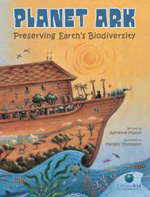 Another winning title from the CitizenKid collection of books published to foster global awareness, this book describes Earth’s biodiversity while explaining the effects of the loss of one species on other living things. Reminding readers that only a small portion of Earth’s species have been identified by scientists, the title celebrates the planet’s bounties while also sounding cautionary notes about the effects of alien species on native species, overexploitation of natural resources, global warming against a backdrop of acrylic illustrations depicting beautiful scenes from the planet. Young readers can also learn about modern-day Noahs intent on preserving Earth’s diversity as well as ways that they can become activists, taking actions to change the world and make sure to Reduce, Reuse, Recycle as well as Rethink, Refuse, and Rejoice. The book makes it clear that attitude adjustments can go a long way toward changing the world for the better.
Another winning title from the CitizenKid collection of books published to foster global awareness, this book describes Earth’s biodiversity while explaining the effects of the loss of one species on other living things. Reminding readers that only a small portion of Earth’s species have been identified by scientists, the title celebrates the planet’s bounties while also sounding cautionary notes about the effects of alien species on native species, overexploitation of natural resources, global warming against a backdrop of acrylic illustrations depicting beautiful scenes from the planet. Young readers can also learn about modern-day Noahs intent on preserving Earth’s diversity as well as ways that they can become activists, taking actions to change the world and make sure to Reduce, Reuse, Recycle as well as Rethink, Refuse, and Rejoice. The book makes it clear that attitude adjustments can go a long way toward changing the world for the better.
- Barbara A. Ward, Washington State University Pullman.
McCurry, Kristen. (2013). How to draw amazing animals. Illus. by Leonardo Meschini. Mankato, MN: Capstone Press.
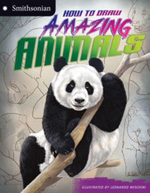 Giving fairly simple step-by-step instructions, readers can use these directions to recreate the drawings of exotic animals from around the globe. Arranged in alphabetical order by animal, each double page spread offers 4 steps to accomplish the basic drawing ending with a colorized picture with a slight background ecosystem included for the backdrop setting of the animal. This will be a fun addition to other drawing books usually enjoyed by students, especially those who need help getting started in their artistic endeavors. Enjoy this video on drawing animals that might prove interesting for students.
Giving fairly simple step-by-step instructions, readers can use these directions to recreate the drawings of exotic animals from around the globe. Arranged in alphabetical order by animal, each double page spread offers 4 steps to accomplish the basic drawing ending with a colorized picture with a slight background ecosystem included for the backdrop setting of the animal. This will be a fun addition to other drawing books usually enjoyed by students, especially those who need help getting started in their artistic endeavors. Enjoy this video on drawing animals that might prove interesting for students.
- Karen Hildebrand, Ohio Library and Reading Consultant
Montgomery, Heather L. (2013). Wild discoveries: Wacky new animals. New York: Scholastic.
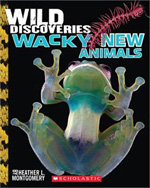 Scientists conjecture that despite the diversity of Earth’s living things, six million different animals may still be undiscovered and unknown to humans. Organized according to locations [rain forests, oceans, islands, mountains, and wacky places] and then concluding with a chapter dedicated to how young scientists are adding to what is known about the Earth’s inhabitants, this book introduces readers to some of the most recently identified animals found between 2007 and 2012. Readers will be intrigued by the photographs and descriptions of the gray-faced sengi, found only in the Udzungwa Mountains, the psychedelic frogfish whose swirls of colors are meant as camouflage, and the wattled smoky honeyeater that blushes when it becomes excited or angry. In addition to nifty animals such as the snot flower that resembles exactly that, the book discusses a handful of discoveries that aren’t animals at all. Perfect for browsing and sharing with others, this title provides proof that there are still scientific mysteries to unravel.
Scientists conjecture that despite the diversity of Earth’s living things, six million different animals may still be undiscovered and unknown to humans. Organized according to locations [rain forests, oceans, islands, mountains, and wacky places] and then concluding with a chapter dedicated to how young scientists are adding to what is known about the Earth’s inhabitants, this book introduces readers to some of the most recently identified animals found between 2007 and 2012. Readers will be intrigued by the photographs and descriptions of the gray-faced sengi, found only in the Udzungwa Mountains, the psychedelic frogfish whose swirls of colors are meant as camouflage, and the wattled smoky honeyeater that blushes when it becomes excited or angry. In addition to nifty animals such as the snot flower that resembles exactly that, the book discusses a handful of discoveries that aren’t animals at all. Perfect for browsing and sharing with others, this title provides proof that there are still scientific mysteries to unravel.
- Barbara A. Ward, Washington State University Pullman
Spilsbury, Louise. (2013). A mob of meerkats and other mammal groups. Portsmouth, NH: Heinemann Library/ Houghton Mifflin Harcourt.
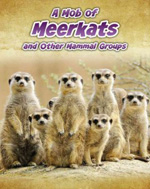 Scattered throughout the south of Africa are communities of meerkats. Author Louise Spilsbury has written a thorough description of life among a colony of meerkats. Each page has a photograph and fact box. Included within the double page spreads is a fact box labeled, “Did You Know?” Other labeled facts boxes that appear regularly throughout the book are “Human Interaction” and “Habitat in Danger.” The final chapters of the book discuss other African mammal communities as a means to compare with the meerkats. Lions, elephants and naked mole rats are the other groups mentioned. Introduce meerkats with this short video from National Geographic.
Scattered throughout the south of Africa are communities of meerkats. Author Louise Spilsbury has written a thorough description of life among a colony of meerkats. Each page has a photograph and fact box. Included within the double page spreads is a fact box labeled, “Did You Know?” Other labeled facts boxes that appear regularly throughout the book are “Human Interaction” and “Habitat in Danger.” The final chapters of the book discuss other African mammal communities as a means to compare with the meerkats. Lions, elephants and naked mole rats are the other groups mentioned. Introduce meerkats with this short video from National Geographic.
- Karen Hildebrand, Ohio Library and Reading Consultant
These reviews are submitted by members of the International Reading Association's Children's Literature and Reading Special Interest Group (CL/R SIG) and are published weekly on Reading Today Online. The International Reading Association partners with the National Council of Teachers of English and Verizon Thinkfinity to produce ReadWriteThink.org, a website devoted to providing literacy instruction and interactive resources for grades K–12.